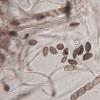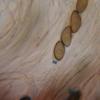
12-12-2025 18:39
Mirek GrycHello everyone.Macrofeatures similar to Mollisia b

09-12-2025 12:06
 Andgelo Mombert
Andgelo Mombert
Bonjour,Je recherche l'article concernant Hypobryo

07-12-2025 16:07
Arnold BüschlenHallo, ich habe in einer Moos-Aufsammlung (epiphy

08-12-2025 21:04
Mark Stevens"Hello everyone,I'm relatively new to microscopy (

08-12-2025 18:59
 Lothar Krieglsteiner
Lothar Krieglsteiner
.. found by a seminar-participant, I do not know t

08-12-2025 17:37
 Lothar Krieglsteiner
Lothar Krieglsteiner
20.6.25, on branch of Abies infected and thickened
noir sur Castaneus
Jean Pierre Dechaume,
23-03-2011 21:45
 Bien malheureux de ne pas arriver au genre...
Bien malheureux de ne pas arriver au genre...Champignon érompant sur Castaneus, mais vieux, noir peut-être par l'âge.
stipité à la manière des Ombrophila, gélatineux, 1cm de diam.
Spores presque noires, 10-14 X 6 microns
Paraphyses filiformes.
Lugol net positif.
J'avais pensé au départ à de vieux Ionomidotis, qui est fréquent chez moi, l'aspect était voisin. Puis à un Encoelia, mais c'est impossible en micro.
Même si mon champignon est vieux, y a-t-il possibilité d'envisager un genre?
Merci beaucoup d'avance
jean pierre
Hans-Otto Baral,
23-03-2011 21:50

Re:noir sur Castaneus
Bulgaria inquinans. Asci contain 4 brown spores and 4 smaller hyaline.
Did you find it recently or in autumn? Breitenbach say Oct.-March.
Zotto
Did you find it recently or in autumn? Breitenbach say Oct.-March.
Zotto
Jean Pierre Dechaume,
23-03-2011 21:55

Re:noir sur Castaneus
Je suis désolé de ne pas avoir cru à de vieux Bulgaria inquinans, mes champignons étant chétifs et desséchés..
mille excuses... Je n'avais jamais fait la micro de ce champignon...
merci Zotto
jean pierre
mille excuses... Je n'avais jamais fait la micro de ce champignon...
merci Zotto
jean pierre
RENE BEILLIEU,
23-03-2011 22:47
Re:noir sur Castaneus
Jean- Pierre, j'y avais pensé mais confirmé par Zotto c'est encore mieux....
Cela nous a permis de revoir 1 espèce non courante en Provence.
Merci et à la prochaine.....R B
Cela nous a permis de revoir 1 espèce non courante en Provence.
Merci et à la prochaine.....R B
Jean Pierre Dechaume,
23-03-2011 23:13

Re:noir sur Castaneus
Intéressant de savoir qu'elle est rare dans le sud, alors qu'elle couvre entièrement les piles de bois de chêne coupé dans l'année chez nous, en automne...
Et qu'on passe notre temps à expliquer que ça tache les mains, contrairement aux Exidia...
Et là, je suis passé à côté...
Sorti du contexte...
Bonsoir
jean pierre
Et qu'on passe notre temps à expliquer que ça tache les mains, contrairement aux Exidia...
Et là, je suis passé à côté...
Sorti du contexte...
Bonsoir
jean pierre
Luc Bailly,
24-03-2011 22:38
Re:noir sur Castaneus
Pas étonnant pour moi de trouver une espèce réputée "du chêne" sur châtaignier. Les deux arbres ont un chimisme très voisin.
Amitiés - LUC.
Amitiés - LUC.
Martin Bemmann,
24-03-2011 23:15

Re:noir sur Castaneus
Yes Luc,
I can add another confirming observation: I found Incrucipulum ciliare (reportedly growing mainly on oak leaves) up to now only on leaves of Castanea sativa and even of Juglans. Maybe these are just tannin loving fungi...
Regards,
Martin
I can add another confirming observation: I found Incrucipulum ciliare (reportedly growing mainly on oak leaves) up to now only on leaves of Castanea sativa and even of Juglans. Maybe these are just tannin loving fungi...
Regards,
Martin
Hans-Otto Baral,
24-03-2011 23:33

Re:noir sur Castaneus
I saw that species (I. ciliare) exactly 50x on Quercus leaves, 7x on Castanea, 3x on Fagus, 1x on Acer. But I do not live ina Castanea region.
Zotto
Zotto
Martin Bemmann,
25-03-2011 00:07

Re:noir sur Castaneus
Hi Zotto,
in "my" forest Quercus to Castanea are 20:1 one only I guess, but this is maybe still quite a frequent appearance for Castanea. And it may be just a coincidence that I didn't find I.c.on oak leaves yet...
But this was not my point, but the possibility that not the Genus but the chemical composition of the substratum may attract those fungi.
Best regards,
Martin
in "my" forest Quercus to Castanea are 20:1 one only I guess, but this is maybe still quite a frequent appearance for Castanea. And it may be just a coincidence that I didn't find I.c.on oak leaves yet...
But this was not my point, but the possibility that not the Genus but the chemical composition of the substratum may attract those fungi.
Best regards,
Martin
Hans-Otto Baral,
25-03-2011 08:48

Re:noir sur Castaneus
Quercus and Castanea are very closely related genera, but we know virtually nothing about the chemical background of host specificity.
Zotto
Zotto


